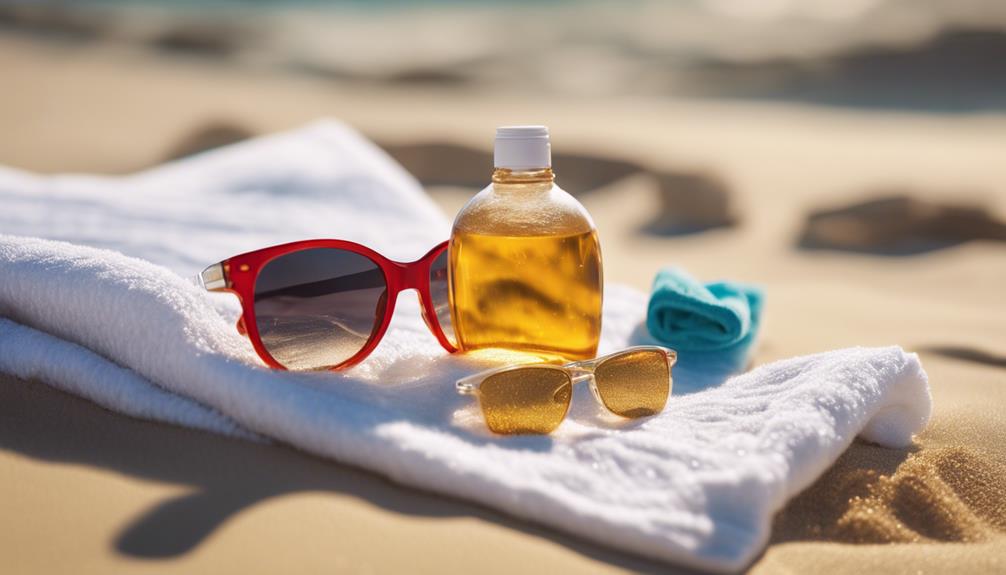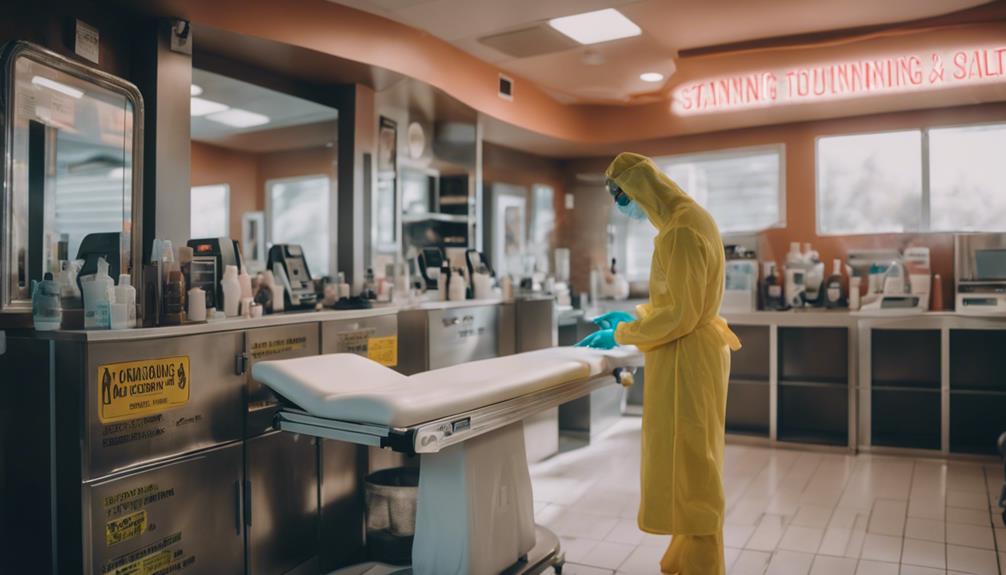Tanning bronzers allow you to achieve a gorgeous, sun-kissed glow without harmful UV exposure. They include DHA, which tans the skin’s outer layer and produces a natural-looking tan that can last up to ten days. You have the option of choosing instant bronzers for immediate color or gradual ones that develop over time. Using effective application techniques, such as exfoliating and using mitts, ensures a uniform result. Remember to moisturize regularly to maintain your glow and follow safety tips to prevent any mishaps. If you would like to learn more secrets about selecting and using tanning bronzers effectively, just keep exploring!
Key Takeaways
- Tanning bronzers use DHA to create a sun-kissed glow without UV exposure, lasting up to 10 days.
- Instant bronzers provide immediate color, while gradual bronzers develop over hours for a natural look.
- Key ingredients like Aloe Vera and Glycerin enhance hydration and skin texture, ensuring a healthy appearance.
- Proper application techniques, including exfoliation and using tanning mitts, prevent patchiness and ensure even coverage.
Understanding Tanning Bronzers
Understanding tanning bronzers is essential if you want to achieve a natural-looking, sun-kissed glow without the risks of UV exposure.
Tanning bronzers work by darkening the skin's top layer, giving you that desired glow without needing to bask in the sun. The primary ingredient, DHA, creates a faux tan that can last up to 10 days, while natural bronzers provide immediate but temporary results.
You can choose between instant bronzers for quick color or gradual bronzers that develop over time. With the right bronzer, you can easily mimic a tropical vacation look.
Plus, many products include additional ingredients that enhance hydration and skin texture, making them a great choice for maintaining healthy, glowing skin.
Key Ingredients to Look For
When choosing a tanning bronzer, it's important to look for key ingredients that enhance both the color and overall health of your skin. Focus on products containing DHA for a long-lasting tan, along with hydrating ingredients like aloe vera or glycerin to keep your skin moisturized. Natural extracts such as coffee or green tea can also boost skin firmness and provide antioxidants. Here's a quick reference table to help you:
| Ingredient | Benefits | Look For In: |
|---|---|---|
| DHA | Long-lasting faux tan | Gradual bronzers |
| Aloe Vera | Hydration and soothing | All bronzer types |
| Coffee Extract | Firmness and antioxidants | Natural bronzers |
| Glycerin | Moisture retention | Any bronzer type |
Choosing wisely will guarantee a beautiful, healthy glow!
Effective Application Techniques

To achieve a flawless tan, start by exfoliating your skin to create a smooth base and prevent patchiness.
Use a tanning mitt or gloves to avoid staining your palms and guarantee an even application.
Begin with a small amount of bronzer; you can always add more to achieve your desired depth.
Pay special attention to rough areas like elbows, knees, and ankles, as they tend to absorb more product and can become darker than the surrounding skin.
Once applied, allow the bronzer to dry completely before getting dressed to prevent transfer onto your clothes.
Essential Safety Tips
Before diving into tanning bronzers, it's important to keep safety in mind to guarantee a smooth and enjoyable experience. Here are some vital tips to follow:
| Safety Tip | Description | Importance |
|---|---|---|
| Conduct a Patch Test | Test a small area for allergic reactions. | Prevents adverse reactions. |
| Know Your DHA Levels | Use products with appropriate DHA concentrations. | Avoid undesirable results. |
| Rinse Off After Use | Clean your skin post-tanning to maintain hygiene. | Keeps skin healthy and prevents buildup. |
| Focus on Hydration | Use tan extenders and moisturizers regularly. | Prolongs your bronzed appearance. |
Maintaining Your Tan

Regularly moisturizing your skin is essential for maintaining your tan and ensuring it looks vibrant and even. Use a hydrating lotion that's specifically formulated for tanned skin to extend the life of your bronzer. Apply it daily, focusing on areas that tend to dry out, like elbows and knees.
Additionally, avoid long, hot showers, as they can strip away your tan faster. Opt for gentle, sulfate-free cleansers to preserve the color.
If you want to prolong your tan, consider using tan extenders; they're designed to enhance and maintain your bronzed glow.
Comparing Bronzer Types
When choosing between bronzer types, it's essential to understand the differences between natural and DHA bronzers to achieve your desired tan.
Natural bronzers offer immediate results, providing a quick sun-kissed glow that lasts about four days. However, these tans wash off easily, making them ideal for special occasions.
On the other hand, DHA bronzers develop gradually, reacting with your skin to create a deeper tan that can last up to ten days. They require a few hours to show full results, but the longevity makes them a favorite.
Consider your skin type, desired results, and how long you want your tan to last when selecting the right bronzer for you.
Common Myths and Misconceptions

Tanning bronzers are often surrounded by myths that can lead to confusion about their effectiveness and safety.
One common misconception is that bronzers provide sun protection; they don't, so always apply sunscreen.
Another myth suggests that using bronzers will turn your skin orange. In reality, quality products with DHA offer a natural-looking tan when applied correctly.
Some believe that bronzers stain clothes permanently, but most formulas wash out easily if treated promptly.
Additionally, many think bronzers are only for fair skin, but they're suitable for all skin tones—just choose the right shade.
How Do Tanning Bronzers Compare to Bronzer Lotions for Safe Tanning?
When it comes to safer tanning bronzer lotions, there are pros and cons to consider. Tanning bronzers provide instant color, but may streak or rub off. Bronzer lotions offer gradual color and can be more hydrating, but require regular use for results. It’s important to find the best option for your skin type.
Conclusion
Now that you've revealed the secrets of tanning bronzers, it's time to glow like you just stepped off a sun-soaked beach in the '80s.
With the right products, techniques, and care, you can achieve that radiant look without the risks of UV exposure.
Embrace your luminous self and enjoy the confidence that comes with a beautifully bronzed complexion.
So, grab your favorite bronzer and get ready to shine brighter than a disco ball at a summer party!










